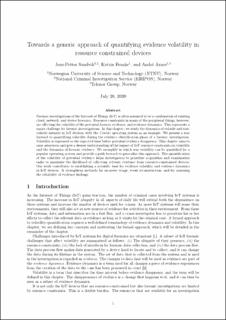Towards a Generic Approach of Quantifying Evidence Volatility in Resource Constrained Devices
Chapter
Accepted version

Åpne
Permanent lenke
https://hdl.handle.net/11250/2827042Utgivelsesdato
2021Metadata
Vis full innførselSamlinger
Originalversjon
10.1007/978-3-030-60425-7_2Sammendrag
Forensic investigations of the Internet of Things (IoT) is often assumed to be a combination of existing cloud, network, and device forensics. Resource constraints in many of the peripheral things, however, are affecting the volatility of the potential forensic evidence, and evidence dynamics. This represents a major challenge for forensic investigations. In this chapter, we study the dynamics of volatile and non-volatile memory in IoT devices, with the Contiki operating system as an example. We present a way forward to quantifying volatility during the evidence identification phase of a forensic investigation. Volatility is expressed as the expected time before potential evidence disappears. This chapter aims to raise awareness and give a deeper understanding of the impact of IoT resource constraints on volatility and the dynamics of forensic evidence. We exemplify in which way volatility can be quantified for a popular operating system and provide a path forward to generalize this approach. The quantification of the volatility of potential evidence helps investigators to prioritize acquisition and examination tasks to maximize the likelihood of collecting relevant evidence from resource-constrained devices. Our work contributes to establishing a scientific base for evidence volatility and evidence dynamics in IoT devices. It strengthens methods for on-scene triage, event reconstruction, and for assessing the reliability of evidence findings.